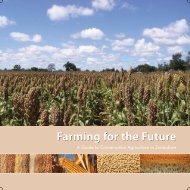Restoring the Soil - Canadian Foodgrains Bank
Restoring the Soil - Canadian Foodgrains Bank
Restoring the Soil - Canadian Foodgrains Bank
Create successful ePaper yourself
Turn your PDF publications into a flip-book with our unique Google optimized e-Paper software.
Green Manure/Cover Crop Systems6336. Honduras. Wild sunflower is a phosphorusaccumulator, so it can be especially important asa green manure in areas where phosphorus is <strong>the</strong>limiting factor in crop production.S20. Maize/wild sunflower-1. Farmersaround Sabana Grande in central Hondurassometimes broadcast wild sunflower(Tithonia diversifolia) seeds into <strong>the</strong>ir fieldsafter <strong>the</strong> maize harvest in November/December (Photo 36). It grows throughout<strong>the</strong> dry season, and provides a goodsource of fertility for <strong>the</strong> following year’scrops. Probably a hundred farmers, atmost, use this recently developed system.S21. Maize/wild sunflower-2. Farmers inwestern Honduras sometimes plant <strong>the</strong>wild sunflower as a contour hedgerow,cutting and spreading <strong>the</strong> branches across<strong>the</strong> field before planting each year in orderto fertilize <strong>the</strong> field. Again, this is ano<strong>the</strong>rsystem recently developed by innovativefarmers. It is probably only used by ahundred farmers or so.37. Honduras. Cowpeas were traditionallyintercropped with maize in much of El Salvador and<strong>the</strong> Pacific coasts of Guatemala, Honduras andNicaragua. Now, because of <strong>the</strong> buying up of landby large-scale farmers and <strong>the</strong> active promotion ofmonocropping by government extension services,<strong>the</strong> practice is used by perhaps only 10% of <strong>the</strong>farmers it once served.S22. Maize/cowpea-1. Cowpea (Vignaunguiculata) varieties, locally known as“alacin” and “pochote,” are intercroppedwith maize in much of sou<strong>the</strong>rn Honduras(Photo 37). They are usually planted at<strong>the</strong> same time and within <strong>the</strong> maize rowto facilitate weeding. Probably somewherebetween 5,000 and 10,000 farmers usethis traditional system. Several thousandfarmers in El Salvador and an equalnumber in nor<strong>the</strong>rn Nicaragua continue to use <strong>the</strong> same system, as do thousandsof farmers on <strong>the</strong> south coast of Guatemala, where cowpeas are called “frijol rienda”or “frijol de tierra.” In Panama, tens of thousands of farmers use virtually <strong>the</strong> sametraditional system.S23. Maize/lablab bean-1. Farmers in <strong>the</strong> village of Pacayas, near Guinope, intercroplablab beans (Dolichos lablab) with <strong>the</strong>ir maize, planting both of <strong>the</strong>m at <strong>the</strong> sametime in May/June when <strong>the</strong> rains start, at a rate of two to four seeds per square metre(Photo 27). In this case, farmers are motivated in large part because <strong>the</strong> organic matterfrom <strong>the</strong> lablab controls <strong>the</strong> nematodes that previously did tremendous damageto <strong>the</strong> irrigated garlic produced during <strong>the</strong> dry season (December to April). Probablyabout 50 farmers use this system, which was recently developed by farmers. A similartraditional system of lablab intercropped with maize is used in nor<strong>the</strong>rn Peru (notablybetween Cajamarca and San Ignacio), where <strong>the</strong> lablab beans are eaten as green peas.In this case, tens of thousands of farmers use <strong>the</strong> system.
















